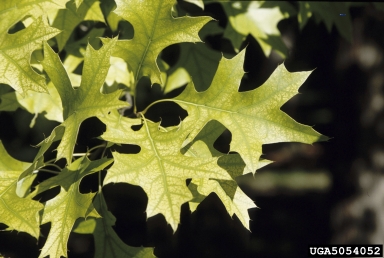Blog, What's Wrong With My Trees?
What’s wrong with my tree? Chlorosis
Do you notice the leaves of your tree turning yellow, but it’s not fall yet? This may be a result of chlorosis, which causes a lack of chlorophyll in the leaves. This essential pigment gives leaves their green color and enables them to make food through photosynthesis. This condition occurs when there is a deficiency of iron or manganese, root damage, too much or too little water or sun, and pathogens.
Common tree species that prominently exhibit chlorosis include pin oak, red maple, white oak, and white pine.

Signs and symptoms of chlorosis
The signs and symptoms of chlorosis can vary depending on a variety of factors, like the pH of the soil and how long the plant has been chlorotic. Symptoms can present in one or two branches or the whole tree. In severe cases, leaf size can be stunted and prematurely drop.
Treating chlorosis
If you’re dealing with chlorosis in your trees, it’s important to know that multiple factors can cause this condition. Fortunately, the treatment of chlorosis is highly dependent on its specific cause. For instance, if poor drainage and soil compaction are responsible for chlorosis, an effective solution might be the introduction of cultural practices like aeration.
Additionally, various treatment options are available to you, including foliar, trunk, and soil treatments. So if you need help with chlorosis, don’t hesitate to consult with your attending arborist. With their expertise, you can be confident that you’ll identify the root cause of the issue and select the best treatment plan to restore your trees to their healthy, vibrant state.
